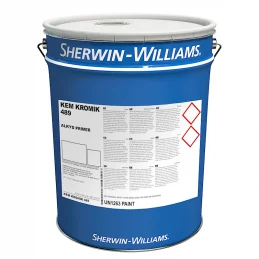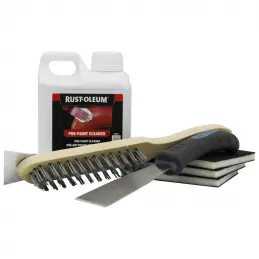Ken-Kromik 489 (formerly known as Sherwin Williams L489) is a highly protective alkyd anticorrosive primer pigmented with minimum 40% zinc phosphate, used as an anticorrosive spraying or brushing primer for steel, and can be applied by brush, roller, conventional and airless sprayers.
Recommended Primers/Topcoats
Indefinitely overcoatable with itself or a wide range of white spirit based undercoats and finishes.
Endorsements
- Complies with BS5493:1977 - Table 4F Type FP3A
- BS476 Part 7 - Surface Spread of Flame Material - for details of substrate/scheme, consult our Technical Team.
Surface Preparation
Ensure surfaces to be coated are dry and free from all visible traces of surface contaminants.
Application Equipment
Can be applied by brush and roller, as well as conventional and airless sprayers:
Airless Spray
- Nozzle Size: 0.46mm (18 thou)
- Fan Angle: 65°
- Operating Pressure: 140kg/cm² (2000 psi)
The airless spray details given above are intended as a guide only. Details such as fluid hose length and diameter, paint temperature and job shape and size all have an effect on the spray tip and operating pressure chosen. However, the operating pressure should be the lowest possible consistent with satisfactory atomisation. As conditions will vary from job to job, it is the applicators’ responsibility to ensure that the equipment in use has been set up to give the best results. If in doubt our technical team should be consulted
Conventional Spray
- Nozzle Size: 1.27mm (50 thou)
- Atomising Pressure: 3.5kg/cm² (50 psi)
- Fluid Pressure: 0.7kg/cm² (10 psi)
The details of atomising pressure, fluid pressure and nozzle size are given as a guide. It may be found that slight variations of pressure will provide optimum atomisation in some circumstances according to the set up in use. Atomising air pressure depends on the air cap in use and the fl uid pressure depends on the length of line and direction of feed i.e. horizontal or vertical.
For application by conventional spray, thin up to 5%. Wet film thickness should be adjusted accordingly. NB - Thinning will affect VOC compliance.
Application Conditions & Overcoating
In conditions of high relative humidity, ie 80-85% good ventilation conditions are essential. Substrate temperature shall be at least 3°C above the dew point and always above 0°C.
Application at ambient air temperatures below 5°C is not recommended.
The maximum air and substrate temperature for application is 50oC providing conditions allow satisfactory application and film formation. If the air and substrate temperatures exceed 50oC and coatings are applied under these conditions, paint film defects such as dry spray, bubbling and pinholing etc, can occur within the coating. If for any reason it is desired to apply at a higher temperature, please seek advice of our Technical Team.
Additional Notes
Any skin that may form on the surface of the paint in the container should be removed carefully to avoid the necessity of sieving the paint.
Numerical values quoted for physical data may vary slightly from batch to batch.
Typical Thickness and Coverage
Dry film thickness
75 microns
Wet film thickness
129 microns
Theoretical coverage
7.7m²/ltr*
*This figure makes no allowance for surface profile, uneven application, overspray or losses in containers and equipment. Film thickness will vary depending on actual use and specification.
Practical Application Rates
Microns per coat
| Airless Spray | Conventional Sprayer | Brush | Roller |
|---|
| Dry | 75* | 75 | 50 | 45 |
| Wet | 129 | 129 | 85 | 78 |
* Maximum sag tolerance with overlap typically 100μm wet (50μm dry) by airless spray
Average Drying Times
| 15°C | 23°C | 35°C |
|---|
| To touch: | 4 hours | 2 hours | 1½ hours |
| To recoat: | 24 hours | 16 hours | 12 hours |
| To handle: | 24 hours | 16 hours | 12 hours |
These figures are given as a guide only. Factors such as air movement and humidity must also be considered.




